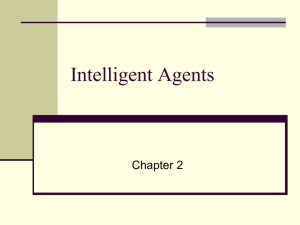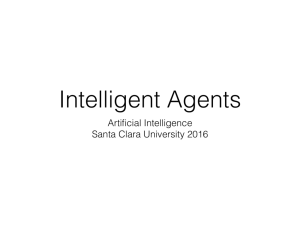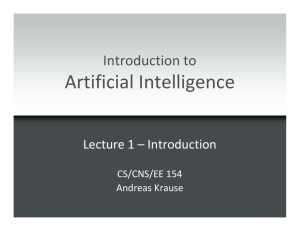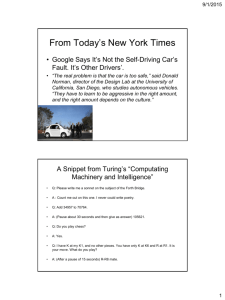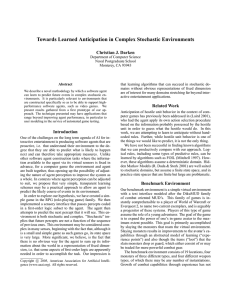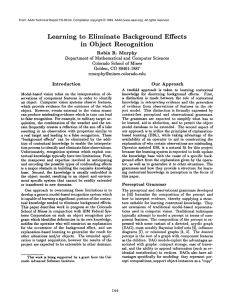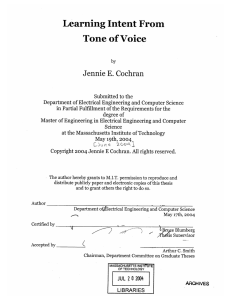Intelligent Agents
advertisement
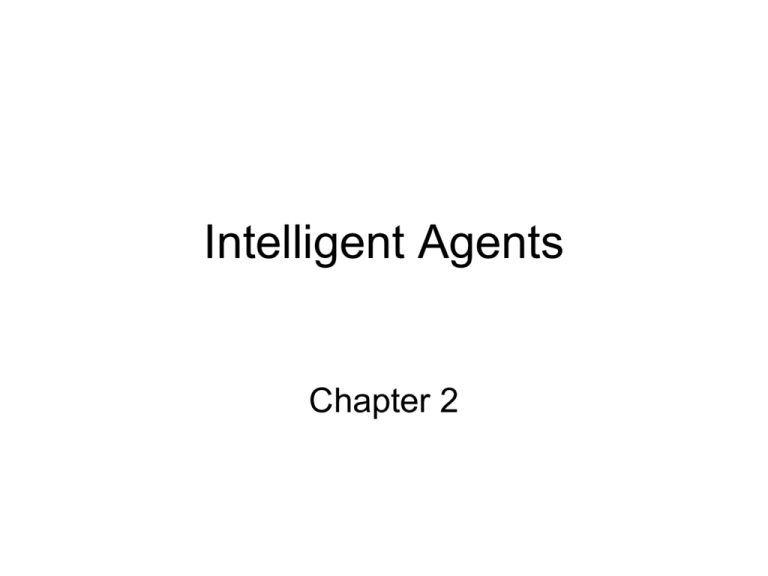
Intelligent Agents Chapter 2 Outline • Agents and environments • Rationality • PEAS (Performance measure, Environment, Actuators, Sensors) • Environment types • Agent types Agents An agent is an entity that perceives and acts An agent is anything that can be viewed as perceiving its environment through sensors and acting upon that environment through actuators Human agent: eyes, ears, and other organs for sensors; hands,legs, mouth, and other body parts for actuators Robotic agent: cameras and infrared range finders for sensors; various motors for actuators • Percept refers to the agent’s perceptual input at a given instant • Percept Sequence is a complete history of percepts. Agents and environments • The agent function maps from percept histories to actions: [f: P* A] • The agent program runs on the physical architecture to produce f • agent = architecture + program Vacuum-cleaner world Percepts: location and contents, e.g., [A,Dirty] Actions: Left, Right, Suck, NoOp A vacuum-cleaner function Percept Sequence Action [A, Clean] Right [A, Dirty] Suck [B, Clean] Left [B, Dirty] Suck [A, Clean], [A, Clean] Right [A, Clean], [A, Dirty] Suck … The Vacuum-cleaner world function REFLEX-VACUUM-AGENT ([location, status]) return an action if status == Dirty then return Suck else if location == A then return Right else if location == B then return Left Rational agents An agent should strive to "do the right thing", based on what it can perceive and the actions it can perform. The right action is the one that will cause the agent to be most successful Performance measure: An objective criterion for success of an agent's behavior E.g., performance measure of a vacuum-cleaner agent could be amount of dirt cleaned up, amount of time taken, amount of electricity consumed, amount of noise generated, etc. Rational agents Rational Agent: For each possible percept sequence, a rational agent should select an action that is expected to maximize its performance measure, given the evidence provided by the percept sequence and whatever built-in knowledge the agent has. Rational agents Rationality is distinct from omniscience (allknowing with infinite knowledge) Agents can perform actions in order to modify future percepts so as to obtain useful information (information gathering, exploration) An agent is autonomous if its behavior is determined by its own experience (with ability to learn and adapt) Rationality The proposed definition requires: • Information gathering/exploration – To maximize future rewards • Learn from percepts – Extending prior knowledge • Agent autonomy – Compensate for incorrect prior knowledge The nature of environments: PEAS PEAS: Performance measure, Environment, Actuators, Sensors Must first specify the setting for intelligent agent design Consider, e.g., the task of designing an automated taxi driver: – – – – Performance measure Environment Actuators Sensors The nature of environments: PEAS Must first specify the setting for intelligent agent design Consider, e.g., the task of designing an automated taxi driver: – Performance measure: Safe, fast, legal, comfortable trip, maximize profits – Environment: Roads, other traffic, pedestrians, customers – Actuators: Steering wheel, accelerator, brake, signal, horn – Sensors: Cameras, sonar, speedometer, GPS, odometer, engine sensors, keyboard PEAS Agent: Medical diagnosis system – Performance measure: Healthy patient, minimize costs, lawsuits – Environment: Patient, hospital, staff – Actuators: Screen display (questions, tests, diagnoses, treatments, referrals) – Sensors: Keyboard (entry of symptoms, findings, patient's answers) PEAS Agent: Part-picking robot – Performance measure: Percentage of parts in correct bins – Environment: Conveyor belt with parts, bins – Actuators: Jointed arm and hand – Sensors: Camera, joint angle sensors Environment types • Fully observable (vs. partially observable): An agent's sensors give it access to the complete state of the environment at each point in time. • Deterministic (vs. stochastic): The next state of the environment is completely determined by the current state and the action executed by the agent. (If the environment is deterministic except for the actions of other agents, then the environment is strategic) • Episodic (vs. sequential): The agent's experience is divided into atomic "episodes" (each episode consists of the agent perceiving and then performing a single action), and the choice of action in each episode depends only on the episode itself. Environment types • Static (vs. dynamic): The environment is unchanged while an agent is deliberating. (The environment is semidynamic if the environment itself does not change with the passage of time but the agent's performance score does) • Discrete (vs. continuous): A limited number of distinct, clearly defined percepts and actions. • Single agent (vs. multiagent): An agent operating by itself in an environment. Environment types Fully observable Deterministic Episodic Static Discrete Single agent Chess with a clock Yes Strategic No Semi Yes No Chess without a clock Yes Strategic No Yes Yes No Taxi driving No No No No No No • The environment type largely determines the agent design • The real world is (of course) partially observable, stochastic, sequential, dynamic, continuous, multi-agent Environment types • The simplest environment is – Fully observable, deterministic, episodic, static, discrete and single-agent. • Most real situations are: – Partially observable, stochastic, sequential, dynamic, continuous and multi-agent. Agent functions and programs • An agent is completely specified by the agent function mapping percept sequences to actions • One agent function (or a small equivalence class) is rational • Aim: find a way to implement the rational agent function concisely Table-lookup agent Function TABLE-DRIVEN_AGENT(percept) returns an action static: percepts, a sequence initially empty table, a table of actions, indexed by percept sequence append percept to the end of percepts action LOOKUP(percepts, table) return action • Drawbacks: • Huge table • Take a long time to build the table • No autonomy • Even with learning, need a long time to learn the table entries Agent types • Four basic types in order of increasing generality: • • • • Simple reflex agents Model-based reflex agents Goal-based agents Utility-based agents The vacuum-cleaner world function REFLEX-VACUUM-AGENT ([location, status]) return an action if status == Dirty then return Suck else if location == A then return Right else if location == B then return Left Reduction from 4T to 4 entries Simple reflex agents • Select action on the basis of only the current percept. – E.g. the vacuum-agent • Large reduction in possible percept/action situations(next page). • Implemented through condition-action rules – If dirty then suck Simple reflex agent function SIMPLE-REFLEX-AGENT(percept) returns an action static: rules, a set of condition-action rules state INTERPRET-INPUT(percept) rule RULE-MATCH(state, rules) action RULE-ACTION[rule] return action Will only work if the environment is fully observable otherwise infinite loops may occur. Model-based reflex agents • To tackle partially observable environments. – Maintain internal state • Over time update state using world knowledge – How does the world change. – How do actions affect world. Model of World Model-based reflex agents function REFLEX-AGENT-WITH-STATE(percept) returns an action static: rules, a set of condition-action rules state, a description of the current world state action, the most recent action. state UPDATE-STATE(state, action, percept) rule RULE-MATCH(state, rule) action RULE-ACTION[rule] return action Goal-based agents • The agent needs a goal to know which situations are desirable. – Things become difficult when long sequences of actions are required to find the goal. • Typically investigated in search and planning research. • Major difference: future is taken into account • Is more flexible since knowledge is represented explicitly and can be manipulated. Utility-based agents • Certain goals can be reached in different ways. – Some are better, have a higher utility. • Utility function maps a (sequence of) state(s) onto a real number. • Improves on goals: – Selecting between conflicting goals – Select appropriately between several goals based on likelihood of success. Learning agents • All previous agent-programs describe methods for selecting actions. – Yet it does not explain the origin of these programs. – Learning mechanisms can be used to perform this task. – Teach them instead of instructing them. – Advantage is the robustness of the program toward initially unknown environments. Summary: Intelligent Agents • An agent perceives and acts in an environment, has an architecture, and is implemented by an agent program. • Task environment – PEAS (Performance, Environment, Actuators, Sensors) • The most challenging environments are inaccessible, nondeterministic, dynamic, and continuous. • An ideal agent always chooses the action which maximizes its expected performance, given its percept sequence so far. • An agent program maps from percept to action and updates internal state. – Reflex agents respond immediately to percepts. • simple reflex agents • model-based reflex agents – Goal-based agents act in order to achieve their goal(s). – Utility-based agents maximize their own utility function. • Agents can improve their performance through learning.
